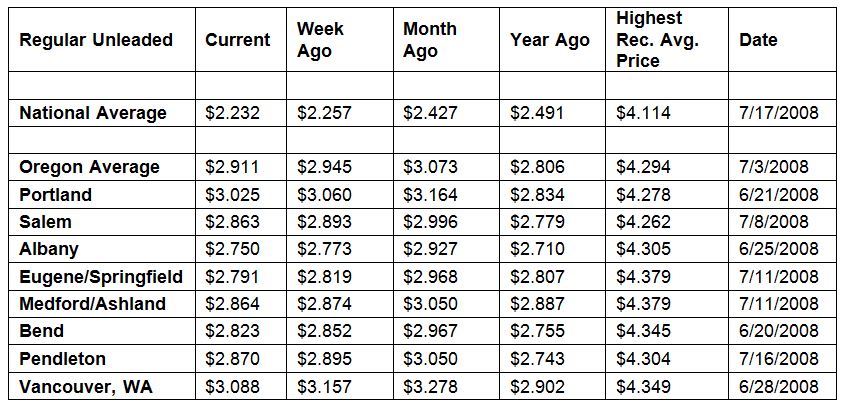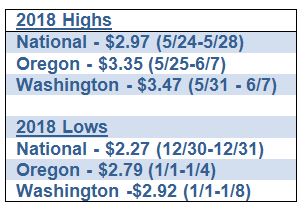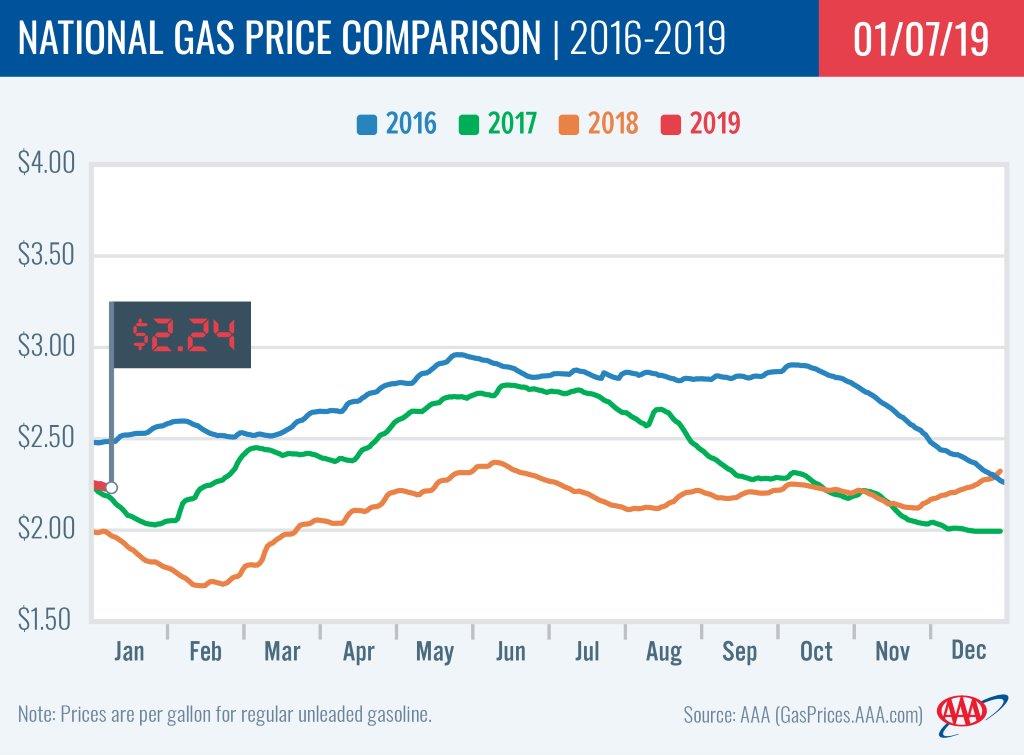PORTLAND, Ore., – Demand for gasoline in the U.S. has fallen to the lowest level since February 2017, putting additional downward pressure on retail pump prices. For the week, the national average for regular loses three cents to $2.23 a gallon while the Oregon average also falls three cents to $2.91. Gas prices have been steadily decreasing for more than two months due to the drop in demand as well as cheaper crude oil prices.
“AAA believes gas prices in 2019 will be a bit lower than in 2018, barring unforeseen events, and pump prices will be the least expensive at the start and end of this year,” says Marie Dodds, public affairs director for AAA Oregon/Idaho. “The national average could peak around $2.75, with Oregon and other western states climbing above $3 a gallon again this year.”
In 2018, the national average peaked at $2.97 in late May. The Oregon average peaked at $3.35 in late May through early June. Oregon first hit $3 a gallon on March 20 and remained above the $3 mark until Christmas Eve when it fell to $2.99. The 2018 low for the national average was $2.27 on the last two days of the year. The Oregon average was at its lowest price on the first three days of 2018.
The latest report from the U.S. Energy Information Administration (EIA) shows gasoline demand at 8.6 million b/d for the week ending December 28. Despite record numbers of people traveling by car over the holidays, demand was down nearly 900,000 bbl, suggesting that overall demand this winter could be lower than expected.
Oregon is one of 46 states and the District of Columbia where gas prices are lower week-over-week. Montana (-9 cents) has the largest drop. Michigan has the largest weekly increase (+5 cents). This week four states have averages at or above $3 a gallon, same as a week ago.
All 50 states and the District of Columbia have lower prices now than a month ago, with every state except Delaware reporting double-digit drops. The national average is 20 cents less and the Oregon average is 16 cents less than a month ago. Montana (-39 cents) has the largest monthly decrease. Delaware (-9.5 cents) has the smallest monthly decrease.
The West Coast continues to have the most expensive gas prices in the nation. California bumps Hawaii out of the top spot this week, with Washington, Alaska, Nevada, Oregon and Arizona rounding out the top seven. Oregon is sixth most expensive, falling from fifth a week ago. On the week, Hawaii (-7 cents) and Alaska (-7 cents) have the largest drops in the region.
| Rank | Region | Price on 1/8/19 | |
| 1 | California | $3.31 | |
| 2 | Hawaii | $3.29 | |
| 3 | Washington | $3.03 | |
| 4 | Alaska | $3.00 | |
| 5 | Nevada | $2.92 | |
| 6 | Oregon | $2.91 | |
| 7 | Arizona | $2.62 | |
| 8 | Connecticut | $2.58 | |
| 9 | New York | $2.58 | |
| 10 | District of Columbia | $2.55 |
EIA’s recent weekly report showed that West Coast gasoline stocks increased by approximately 1.2 million bbl to 28.3 million bbl. Stocks are approximately 4.6 million bbl lower than at this time last year, which could cause prices to spike if there is a supply challenge in the region this week.
The nation’s cheapest markets are Missouri ($1.83) and Arkansas ($1.90). In all, 12 states have averages below $2 a gallon this week compared to 11 states a week ago.
Oregon is one of seven states where drivers are paying more than a year ago to fill up. The national average is 26 cents less and the Oregon average is 11 cents more than a year ago. This is the seventh-largest yearly increase in the country. Arizona (+31 cents) has the greatest year-over-year increase; Nevada (+25 cents) is second; California (+15 cents) is third; Wyoming (+11 cents) is fourth; and Washington (+11 cents) is fifth.
Oil Market Dynamics
Oil prices were volatile last week, as market observers continue to believe that the global crude market is oversupplied. Moreover, analysts are also wary of the impact a potential economic slowdown in 2019 could have on global crude oil demand. In the coming weeks, market observers will look for indications that OPEC’s global pact with large non-OPEC crude producers (including Russia) will reduce crude production by 1.2 million b/d for at least the first six months of 2019, which may help reduce the growing global glut of crude. In turn, this could drive up crude oil prices and, subsequently, gas prices.
EIA’s latest weekly petroleum status report revealed that total domestic crude inventories held steady for the second week at 441.4 million bbl. Domestic crude production also held steady for a second week at a record high of 11.7 million b/d. Steady inventories amid high production underscores how oversupplied the market currently is, while demand for gasoline remains at a two-year low. Additionally, Baker Hughes, Inc. reported that the U.S. lost eight oil rigs last week, bringing the current total of active oil rigs to 877. When compared to the total number of active rigs at this time last year, there are 135 more rigs this year.
At the close of Friday’s formal trading session on the NYMEX, WTI increased 87 cents to settle at $47.96. At the close of Monday’s formal trading session on the NYMEX, WTI added 56 cents to settle at $48.52. Today crude is trading around $49, compared to $47 on Jan. 2 (markets were closed on Jan. 1 for New Year’s Day). Crude prices are down about two percent in the last month and are about $13 per barrel lower than a year ago.
Drivers can find current gas prices along their route with the free AAA Mobile app for iPhone, iPad and Android. The app can also be used to map a route, find discounts, book a hotel and access AAA roadside assistance. Learn more at AAA.com/mobile.
Diesel
For the week, the national average falls four cents to $2.95 a gallon. Oregon’s average drops two cents to $3.15. A year ago the national average for diesel was $2.91 and the Oregon average was $3.05.
Find current fuel prices at GasPrices.AAA.com.
AAA news releases, high resolution images, broadcast-quality video, fact sheets and podcasts are available on the AAA NewsRoom at NewsRoom.AAA.com.




